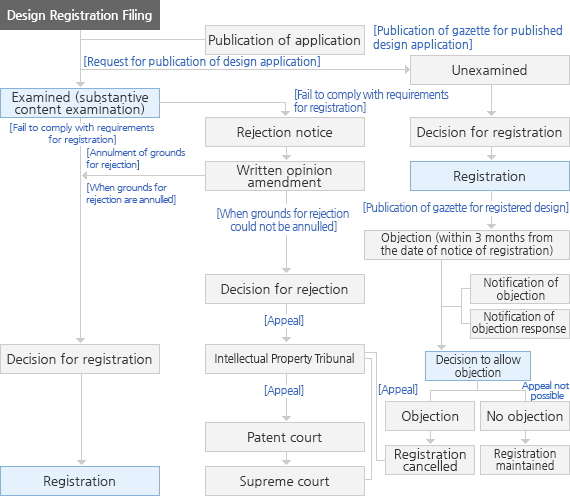ace PATENT OFFICE
Designs Intellectual Property Information Service  Designs
Designs
-
Summary of Designs
-
As a foreign word derived from the English word 'design', design is a term that is a broad concept encompassing product designs for products, visual designs such as advertisement posters, graphic designs, and digital designs, and environment designs for living spaces and environments.
Article 2(i) of the Design Protection Act prescribes that "a design means the shape, pattern, color of an article [a part of an article (with exceptions in Article 12) and script are included, the same in the below] or a combination thereof, which produces an aesthetic impression in the sense of sight.
Thus, according to the Design Protection Act, a design can be said to be a design for the outside of a corporeal article (or a part of said article) that can be the subject of an independent transaction.
-
Design Application and Examination Procedure
-
An application for registering a design can be filed as an examined application for registering a design or an unexamined application for registering a design.
Designs for food products (A1), clothing (B1), bedding (C1), paper printed articles (F3), packaging containers (F4), textile and paper (M1), miscellaneous goods (B2), shoes (B5), teaching materials (F1), office supplies (F2), and the like, which are articles that are highly affected by trends and have short life cycles, should be filed as unexamined applications for registering a design, and other articles should be filed as examined applications for registering a design.
While the articles that can currently be filed as unexamined applications for registering a design are designated into 10 major categories, the rearrangement of these articles and designation methods based on other standards are continuously being evaluated.
-
Design Application Examination/Registration Flowchart
-

-
Revisions for Design Protection Act Enforcement Regulation
(Revised in 2010 and 2011) -
- 3D drawing submission is allowed
- By allowing drawings that have been composed using 3D program files (3DS, DWG, DWF, and IGES) to be submitted, the inconvenience of having to compose drawings separately for filing has been alleviated.
- Drawing composition
methods and number of drawings to be submitted becomes completely free - The existing obligation to compose drawings through orthographic projection methods has been abolished, and the applicant can freely choose the composition method. Also, the number of drawings to be submitted is not limited, providing convenience to clients by allowing them to submit only the number of drawings they want to submit, as long as the overall shape and the essence of creative contents of a design are sufficiently represented instead of having to submit a perspective view and drawings for six faces.
- Categories for unexamined articles are expanded
- The number of major categories for unexamined articles is expanded to 18 major categories (6,200 articles or so) from 10 major categories (including 2,460 articles). Specifically, personal belongings, bags, clothing, congratulating and consolation articles, advertising articles, etc. have been newly added as categories for unexamined articles.
- Categories for one set of
articles are expanded - From 31 categories for one set of articles that could be filed in the past, the categories are expanded to 86 categories in total by adding specialized sportswear sets, etc., in order to better reflect the recent state of product transactions.
